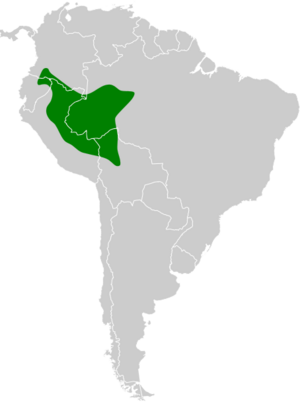Plumbeous antbird facts for kids
Quick facts for kids Plumbeous antbird |
|
|---|---|
 |
|
| Male | |
 |
|
| Female | |
| Conservation status | |
| Scientific classification | |
| Genus: |
Myrmelastes
|
| Species: |
hyperythrus
|
 |
|
| Synonyms | |
|
Myrmeciza hyperythra |
|
The plumbeous antbird (Myrmelastes hyperythrus) is a type of bird. It belongs to the Thamnophilidae family, which includes many antbirds.
You can find this bird in several South American countries. These include Bolivia, Brazil, Colombia, Ecuador, and Peru. It likes to live in warm, wet places. Its natural home is in subtropical or tropical swamps.
About the Plumbeous Antbird
What's in a Name?
The plumbeous antbird was first described in 1855. An English zoologist named Philip Sclater gave it its first scientific name. He called it Thamnophilus hyperythrus.
The name hyperythrus comes from Ancient Greek words. It can mean "beneath red" or simply "reddish." This name likely describes some part of the bird's coloring. Later, Sclater placed this bird in a new group called Myrmelastes in 1858.
How to Spot Them
The plumbeous antbird is about 17 centimeters (about 6.7 inches) long. That's about the length of a regular pencil.
Male and female plumbeous antbirds look different:
- The male bird is mostly a dark gray color. Its wings and tail are a darker, blackish-gray.
- It has bright white spots on its wing feathers.
- A cool feature is the light blue skin around each of its eyes.
The female bird has similar gray upper parts. She also has the white spots on her wings. But her belly is a bright orange-red color!
Other similar birds do not have the blue skin around their eyes. Some are also much blacker or do not have white spots on their wings.
Reproduction and Nests
Scientists first learned about the nests of plumbeous antbirds in 2003. They found two nests in Manú National Park in Peru.
These nests were shaped like open cups. They hung from branches about 0.7 to 1.0 meter (2 to 3 feet) above the ground. The birds built their nests using black root-like structures. They also covered them with dry leaves, held together with spider silk.
Each nest contained two eggs. The eggs had a pinkish-white background. But they were almost completely covered with dark purplish-red streaks. The eggs were about 23 by 17 millimeters (0.9 by 0.7 inches) or 24 by 20 millimeters (0.9 by 0.8 inches) in size.


